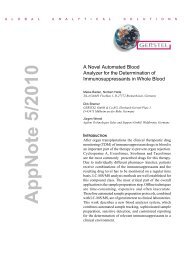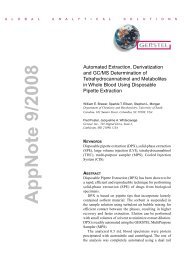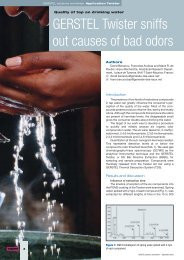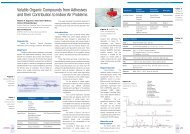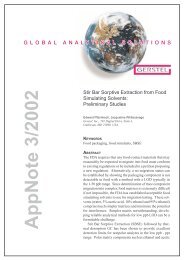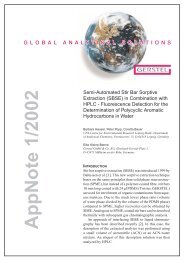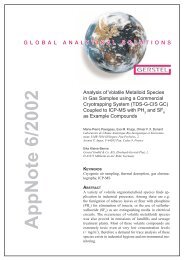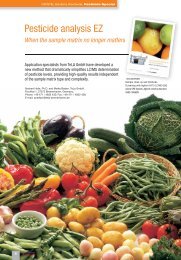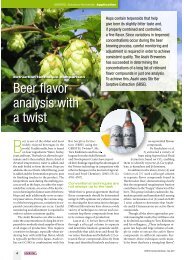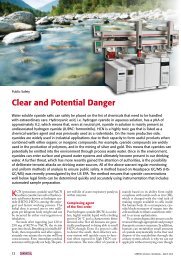Automated DPX process - Gerstel
Automated DPX process - Gerstel
Automated DPX process - Gerstel
You also want an ePaper? Increase the reach of your titles
YUMPU automatically turns print PDFs into web optimized ePapers that Google loves.
GERSTEL Solutions Worldwide Report<br />
Mural in the tomb of Nebamun, soldier in the army of Pharaoh Thutmose IV (Photo: archive).<br />
SPME Total Ion Chromatogram (top) of the Abydos sample and enlarged (12.00-13.60 min) Selected Ion<br />
Chromatograms (Middle), shown along with mass spectra and library mass spectra of select compounds (below).<br />
22<br />
Bureau (TTB). The scope of the project was<br />
to determine volatile and semi-volatile compounds<br />
in the wine residues, but not necessarily<br />
to determine the origins of the wine.<br />
In order to have a historically differentiated<br />
reference, a wine amphora from the Nubian<br />
town of Djebel Adda, dating back to the<br />
year 400 A.D., was analyzed as well.<br />
Wine tasting based<br />
on pottery shards<br />
To look into the soul of a wine that no longer<br />
has a body, the scientists had no choice<br />
but to grind the ancient pottery and extract<br />
the oenological residues from the resulting<br />
powder using acidic or alkaline solutions.<br />
The extracts were filtered and analyzed using<br />
chromatographic techniques. The following<br />
provides an overview of the methods<br />
used for analysis.<br />
Traces of resin and herbs<br />
The results: In both samples, the scientists<br />
identified a range of terpenoids, esters and<br />
alcohols as well as various volatile compounds<br />
and L-tartaric acid. This was definitive<br />
proof that the amphorae and jugs had<br />
contained wine. Further, the identified compounds<br />
indicated that resin and herbs had<br />
been added to the wines, making them a kind<br />
of ancient day Retsina wine, possibly similar<br />
to what is produced, and mainly served<br />
to tourists, in Greece today.<br />
The project provided facts that support<br />
the theory of a preference for wines<br />
enriched with resin and herbs at the court<br />
of the Pharaohs, covering the entire period<br />
from the beginning of the ancient Egyptian<br />
High Culture (Abydos find) until the latter<br />
parts (Djebel Adda find). The herbs may<br />
have been added mainly to produce a sought<br />
after taste or they could have been added<br />
for medicinal purposes. Herbs and tree res-<br />
Section of „Papyrus Ebers“ (1,500 B.C.) a 20 meter long list<br />
of medicinal recipes, and thereby the most comprehensive<br />
documentation of medical knowledge in ancient Egypt<br />
known to man. The content mainly deals with internal<br />
diseases and their treatment. The papyrus was acquired for<br />
the University of Leipzig, Germany in 1872 by Georg Ebers<br />
(1837-1898), Professor of Egyptology.<br />
GERSTEL Solutions Worldwide – March 2009



